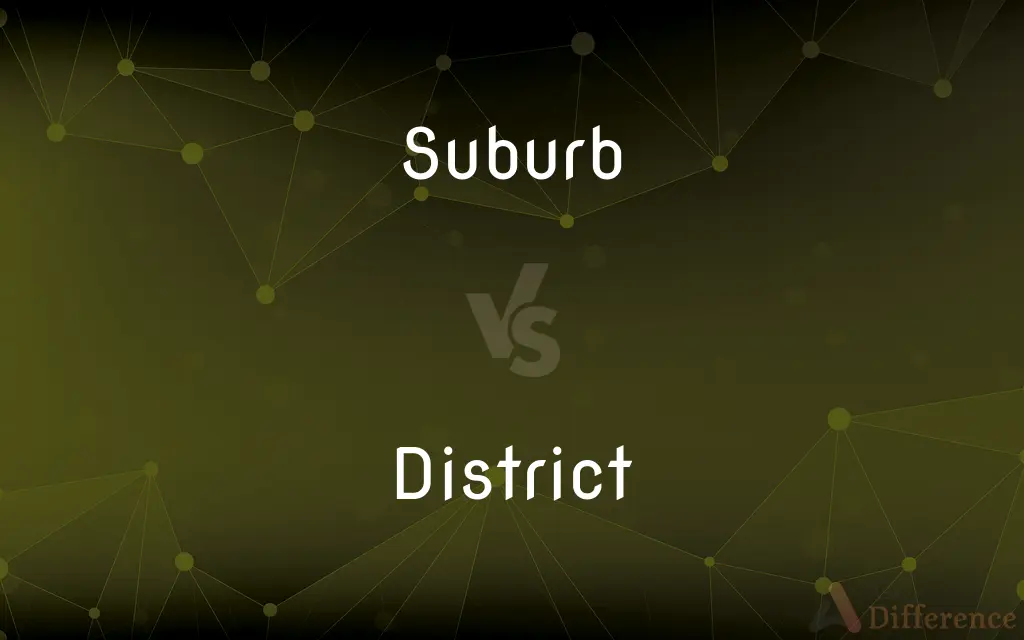Suburb vs. District — What's the Difference?
By Maham Liaqat & Fiza Rafique — Updated on February 29, 2024
Suburbs are residential areas on the outskirts of cities, known for their quieter, more family-oriented environments, whereas districts are administrative or geographical regions within cities or countries, defined for organizational purposes.

Difference Between Suburb and District
Table of Contents
ADVERTISEMENT
Key Differences
Suburbs are primarily residential areas located on the edges of urban cities. They are characterized by lower population density, more green spaces, and a predominance of single-family homes. Districts, in contrast, are defined areas within a larger city or region, often established for administrative, commercial, or political purposes. They can vary widely in character, function, and size, encompassing residential neighborhoods, commercial zones, or industrial areas.
Suburbs offer a quieter, often more family-friendly alternative to city living, with a focus on community and local amenities like parks and schools. Districts serve as a means to organize city planning, governance, and services efficiently.
Suburbs are generally considered separate from the urban core, offering a distinct lifestyle and community, districts are integral parts of cities or regions, each with its unique identity and role. The term "district" can apply to areas within suburbs, emphasizing their function within the broader urban or regional context.
The appeal of suburbs lies in their offering of more space, privacy, and a perceived higher quality of life, attracting families and individuals seeking to escape the hustle and bustle of city centers. Districts, however, are appreciated for their specific contributions to a city's economic, cultural, or residential fabric, depending on their designated purpose.
Both suburbs and districts reflect the diversity of living environments and organizational structures within and around urban areas. While suburbs focus on creating a particular kind of community living space, districts are about categorizing areas for effective management and utilization within the urban framework.
ADVERTISEMENT
Comparison Chart
Definition
Residential area on the outskirts of a city.
An administrative or geographical area within a larger city or region.
Primary Characteristics
Lower population density, more green spaces, family-oriented.
Can be residential, commercial, industrial, etc., defined for specific purposes.
Location
Typically located outside of city centers.
Located within cities or regions, including within suburbs.
Function
Primarily residential with a focus on community living.
Varied, including governance, commerce, industry, or residential organization.
Lifestyle
Quieter, more space, often sought after for family life.
Depends on the district type; can range from bustling commercial hubs to quiet residential zones.
Compare with Definitions
Suburb
Known for community-oriented living.
The suburb was filled with parks and community centers.
District
Integral to city planning and organization.
Each district in the city has its own management office.
Suburb
Characterized by single-family homes.
Most houses in the suburb have their own yards.
District
An area designated for a specific purpose.
The financial district is home to many banks and corporate offices.
Suburb
Typically has lower population density.
The suburb's streets are less crowded than those in the city.
District
Reflects the city's diversity and functionality.
The arts district is known for its galleries and theaters.
Suburb
A residential area outside a city center.
They moved to a suburb for a quieter lifestyle and more space.
District
Varies widely in character and size.
The historic district is preserved for its architectural significance.
Suburb
Offers a blend of urban and rural benefits.
The suburb provided easy city access while maintaining a peaceful environment.
District
Can be administrative, commercial, or residential.
The school district oversees all educational institutions in the area.
Suburb
A suburb (or suburban area or suburbia) is a mixed-use or residential area, existing either as part of a city/urban area, or as a separate residential community within commuting distance of one. Suburbs might have their own political or legal jurisdiction, especially in the United States, but this is not always the case, especially in the United Kingdom where most suburbs are located within the administrative boundaries of cities.
District
A district is a type of administrative division that, in some countries, is managed by the local government. Across the world, areas known as "districts" vary greatly in size, spanning regions or counties, several municipalities, subdivisions of municipalities, school district, or political district.
Suburb
An outlying district of a city, especially a residential one
A highly respectable suburb of Chicago
A working-class suburb
Life is much better in the suburbs
District
A division of an area, as for administrative purposes.
Suburb
A usually residential area or community outlying a city.
District
A region or locality marked by a distinguishing feature
Went to the lake district for their vacation.
Suburb
Suburbs The usually residential region around a major city; the environs.
District
A division of territory; a defined portion of a state, town, or city, etc., made for administrative, electoral, or other purposes; as, a congressional district, judicial district, land district, school district, etc.
To exercise exclusive legislation . . . over such district not exceeding ten miles square.
Suburb
A residential area located on the outskirts of a city or large town that usually includes businesses that cater to its residents; such as schools, grocery stores, shopping centers, restaurants, convenience stores, etc.
District
To divide into districts or limited portions of territory; as, legislatures district States for the choice of representatives.
Suburb
A residential district located on the outskirts of a city
District
A region marked off for administrative or other purposes
Common Curiosities
How does a district differ from a suburb?
A district is a designated area within a city or region for specific administrative, commercial, or residential purposes, unlike a suburb which is primarily residential and located outside city centers.
What types of districts are there?
There are various types of districts, including administrative, commercial, residential, industrial, and educational, each serving different purposes.
Can a suburb contain districts?
Yes, suburbs can contain districts, especially if they are large enough to require their own subdivisions for organizational purposes.
What is the appeal of living in a suburb?
Suburbs appeal to those seeking a quieter lifestyle with more space, green areas, and a community-oriented environment.
Is a district part of urban planning?
Yes, districts are integral to urban planning, helping organize city services, governance, and land use efficiently.
What is a suburb?
A suburb is a residential area located on the outskirts of a city, known for its quieter, more family-friendly environment.
Can the character of a district change over time?
Yes, the character of a district can evolve due to economic, cultural, or developmental changes within the city.
Are suburbs considered part of the urban sprawl?
Yes, suburbs are often considered a key component of urban sprawl, reflecting the spread of a city's population and infrastructure beyond its core.
Why might someone choose to live in a district within a city?
People may choose to live in a city district for its proximity to work, cultural amenities, or specific services not found in suburbs.
What role do districts play in governance?
Districts play a crucial role in governance by facilitating localized administration and services, making management more efficient.
How does public transportation affect suburbs and districts?
Public transportation connects suburbs and districts to city centers, impacting accessibility and potentially the development and desirability of these areas.
How do schools in suburbs compare to those in city districts?
Schools in suburbs often have more space and resources due to lower population density, while schools in city districts may benefit from greater diversity and specialized programs.
How do suburbs impact city growth?
Suburbs can influence city growth by providing overflow housing and encouraging the development of transportation and services to connect them with urban centers.
How do amenities in suburbs compare to those in districts?
Suburban amenities often focus on residential needs and community services, while district amenities can vary widely depending on the district's function.
What is the significance of historical districts?
Historical districts preserve the architectural, cultural, and historical integrity of an area, contributing to a city's identity and tourism.
Share Your Discovery

Previous Comparison
Title vs. Tidal
Next Comparison
Mule vs. PonyAuthor Spotlight
Written by
Maham LiaqatCo-written by
Fiza RafiqueFiza Rafique is a skilled content writer at AskDifference.com, where she meticulously refines and enhances written pieces. Drawing from her vast editorial expertise, Fiza ensures clarity, accuracy, and precision in every article. Passionate about language, she continually seeks to elevate the quality of content for readers worldwide.














































